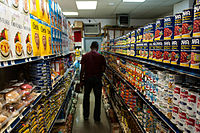
Photo from wikipedia
INTRODUCTION Federal food assistance programs such as the Supplemental Nutrition Assistance Program (SNAP) help address food insecurity, yet many participants still struggle to afford nutritionally adequate foods. The U.S. Department… Click to show full abstract
INTRODUCTION Federal food assistance programs such as the Supplemental Nutrition Assistance Program (SNAP) help address food insecurity, yet many participants still struggle to afford nutritionally adequate foods. The U.S. Department of Agriculture has committed $100 million to the expansion and evaluation of SNAP healthy food incentives, which match SNAP funds spent on produce. However, little is known about who uses SNAP incentives or how often they are used. This study examines patterns and correlates of use of the SNAP incentive Double Up Food Bucks at all eight participating Detroit farmers markets during 2012-2013. METHODS SNAP/Double Up Food Bucks transactions from handwritten farmers market logs (n=21,541) were linked with state administrative SNAP enrollment data. Frequency of incentive use and characteristics of Double Up Food Bucks users relative to the overall Detroit SNAP-enrolled population were examined, as were market-level characteristics associated with program use. Negative binomial regression was used to estimate predictors of repeat transactions (analyses conducted 2015-2017). RESULTS Although demographic characteristics of Double Up Food Bucks users reflected those of the overall Detroit SNAP-enrolled population, Double Up Food Bucks users were poorer and disproportionately female. One third of Double Up Food Bucks users had more than one transaction during the 2-year period. Repeat transactions were directly correlated with identifying as white (incidence rate ratio=2.34, 95% CI=2.11, 2.59, p<0.001), and inversely correlated with driving distance from market of first transaction (incidence rate ratio=0.98 per mile, 95% CI=0.98, 0.99, p<0.001). Rates of repeat transactions also varied significantly by market. CONCLUSIONS Addressing barriers to initial use and return visits can help maximize the impact and reach of SNAP incentives among Americans at highest risk of diet-related disease.
Journal Title: American journal of preventive medicine
Year Published: 2018
Link to full text (if available)
Share on Social Media: Sign Up to like & get
recommendations!